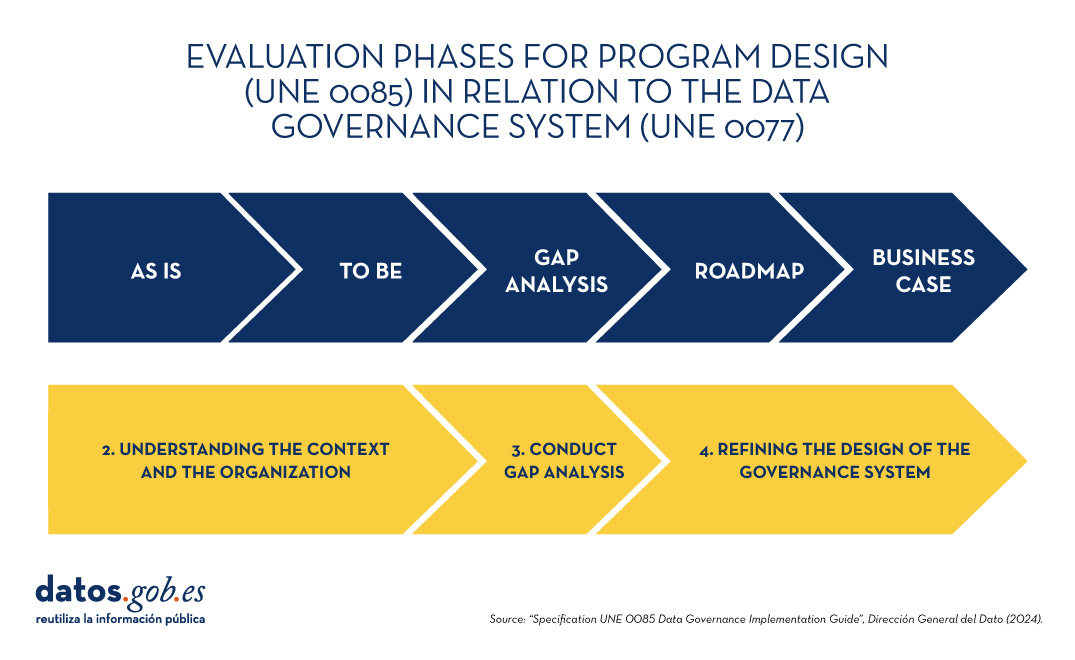
Data governance is crucial for the digital transformation of organisations. It is developed through various axes within the organisation, forming an integral part of the organisational digital transformation plan. In a world where organisations need to constantly reinvent themselves and look for new business models and opportunities to innovate, data governance becomes a key part of moving towards a fairer and more inclusive digital economy, while remaining competitive.
Organisations need to maximise the value of their data, identify new challenges and manage the role of data in the use and development of disruptive technologies such as Artificial Intelligence. Thanks to data governance, it is possible to make informed decisions, improve operational efficiency and ensure regulatory compliance, while ensuring data security and privacy.
To achieve this, it is essential to carry out a planned digital transformation, centred on a strategic data governance plan that complements the organisation's strategic plan. The UNE 0085 guide helps to implement data governance in any organisation and does so by placing special emphasis on the design of the programme through an evaluation cycle based on gap analysis, which must be relevant and decisive for senior management to approve the launch of the programme.
The data governance office, key body of the programme
A data governance programme should identify what data is critical to the organisation, where it resides and how it is used.. This must be accompanied by a management system that coordinates the deployment of data governance, management and quality processes. An integrated approach with other management systems that the organisation may have, such as the business continuity management system or the information security system, is necessary.
The Data Governance Office is the area in charge of coordinating the development of the different components of the data governance and management system, i.e. it is the area that participates in the creation of the guidelines, rules and policies that allow the appropriate treatment of data, as well as ensuring compliance with the different regulations.
The Data Governance Office should be a key body of the programme. It serves as a bridge between business areas, coordinating data owners and data stewards at the organisational level.
UNE 0085: guidelines for implementing data governance
Implementing a data governance programme is not an easy task. To help organisations with this challenge, the new UNE 0085 has been developed, which follows a process approach as opposed to an artefact approach and summarises as a guide the steps to follow to implement such a programme, thus complementing the family of UNE standards on data governance, management and quality 0077, 0078, 0079 and 0080.
This guide:
- It emphasises the importance of the programme being born aligned with the strategic objectives of the organisation, with strong sponsorship.
- Describes at a high level the key aspects that should be covered by the programme.
- Detalla diferentes escenarios tipo, que pueden ayudar a una organización a clarificar por dónde empezar y qué iniciativas debería priorizar, el modelo operativo y roles que necesitará para el despliegue.
- It presents the design of the data governance programme through an evaluation cycle based on gap analysis. It starts with an initial assessment phase (As Is) to show the starting situation of the organisation followed by a second phase in which the scope and objectives of the programme are defined and aligned with the strategic objectives of the organisation phase (To be), to carry out the gap analysis phase. It ends with a business case that includes deliverables such as scope, frameworks, programme objectives and milestones, budget, roadmap and measurable benefits with associated KPIs among other aspects. This use case will serve as the launch of the data governance programme by management and thus its implementation throughout the organisation. The different phases of the cycle in relation to the UNE 0077 data governance system are presented below:

Finally, beyond processes and systems, we cannot forget people and the roles they play in this digital transformation. Data controllers and the entities involved are central to this organisational culture change. It is necessary to manage this change effectively in order to deploy a data governance operating model that fits the needs of each organisation.
It may seem complex to orchestrate and define an exercise of this magnitude, especially with abstract concepts related to data governance. This is where the new data governance office, which each organisation must establish, comes into play. This office will assist in these essential tasks, always following the appropriate frameworks and standards.
It is recommended to follow a methodology that facilitates this work, such as the UNE specifications for data governance, management and quality (0077, 0078, 0079 and 0080). These specifications are now complemented by the new UNE 0085, a practical implementation guide that can be downloaded free of charge from the AENOR website.
The content of this guide can be downloaded freely and free of charge from the AENOR portal through the link below by accessing the purchase section. Access to this family of UNE data specifications is sponsored by the Secretary of State for Digitalization and Artificial Intelligence, Directorate General for Data. Although the download requires prior registration, a 100% discount on the total price is applied at the time of finalizing the purchase. After finalizing the purchase, the selected standard or standards can be accessed from the customer area in “my products” section.


